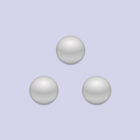nanoComposix guarantees our materials to be stable when stored as recommended for 6 months to over 1 year from the date of shipment for most nanoparticles. However, there are some exceptions, such as our PVP-stabilized 10 nm silver nanospheres.
Why does small PVP Silver behave differently from other metal nanoparticles?
The silver in silver nanoparticles is relatively labile in aqueous environments, being oxidatively released as silver ions. Smaller particles are particularly sensitive to these oxidative ion-release effects because of their high surface to volume ratio. The rate at which this occurs depends on pH, exposure to air, exposure to light, temperature, and the relative oxidative strength of their environment. As colloidal silver ages, the amount of silver ions present can become much higher than when the particles were first prepared. Typically, this rate of silver ion release is greatest in the first few days after processing or dilution and the rate will level off as the silver ion concentration reaches equilibrium with the solid silver. For PVP-stabilized silver, the presence of PVP itself can lead to a very low pH in water and further increase the silver dissolution. These effects tend to be additive and have a strong impact on the stability of PVP-stabilized particles smaller than 30 nm.
This should be contrasted with the citrate-stabilized particles, which are provided in a dilute citrate solution (2 mM) and have 2–3 times longer of an expected shelf life than the PVP silver. The citrate is a reductant and helps protect the silver from oxidation.
What happens as these materials approach and exceed their guaranteed shelf life period?
Silver ion dissolution would normally have a negligible effect on the size and size distribution of the silver nanoparticles in solution. However, in solutions with small (≤ 30 nm) silver nanoparticles stabilized with PVP that have accumulated high silver ion content, we’ve observed that very small (< 1–2 nm) nanoparticles can begin to re-nucleate after ~2 months, depending on the size.
After this ~2 month time period, the particles can still be used, but with the awareness that the size distribution and optical properties of the particles may have shifted since they were first characterized. These materials may contain a population of small (< 1–2 nm) silver nanoparticles. These new smaller particles are generated from the ongoing release of silver ions from the particle surface and subsequent re-nucleation into new smaller silver particles through the reduction of the silver ion, Ag+, to metallic silver, Ag0.
At nanoComposix, our guaranteed specifications are based on the material characteristics at the time of manufacture, as reported in the lot-specific Certificate of Analysis. Because these silver materials can begin to exhibit a new small particle population after ~2 months, we guarantee the shelf life and specifications for that time period. However, these changes are not necessarily an indication of instability or aggregation and may still be okay to use, depending on your application.
When should I stop using the material?
How long you can continue to use these materials depends on your application. For most experiments and applications, the presence of silver ions and a small population of smaller nanoparticles will not have an impact. As a general rule of thumb, we consider that while a small drop in the material’s peak absorbance (a.k.a. optical density or OD) is negligible, a drop in OD of 8% or greater may be an early sign of destabilization and the material may no longer be okay to use. However, keep in mind that your application may be more or less sensitive to these changes in the nanoparticle solution. Other indicators of instability to note are: a change in color (e.g. from yellow to brown or green), significant plating on the inside of the bottle, visible particulates in solution, a change in size of ± 2 nm as determined by TEM, and a change in mass concentration of more than ± 10%.
Please note that the guaranteed 2-month shelf life of our small silver nanoparticles assumes proper storage and handling protocols have been followed and that the material has not been exposed to contamination or other sources of degradation. It is important when using any silver nanoparticles that you limit exposure to air and light and store the material at 2–8oC.
If you would like to continue using your material past the Guaranteed Shelf Life, we encourage you to perform routine quality control checks on your material to ensure its stability before use. If your material does not show signs of instability or degradation, it may be okay to continue using the material for as long as it remains stable. Note that the nature of your project and experiments should be considered when determining appropriate quality control methods and deciding whether to continue using a material. Be sure to continue following the proper storage and handling guidelines for your material(s) to ensure maximum shelf life; see the Storage and Handling guidelines for more information.
If you notice any instability or aggregation in your material within the shelf-life period reported on that product’s webpage, please contact us and we will replace the material at no additional charge once we verify that the materials were stored, handled, and tested appropriately.



